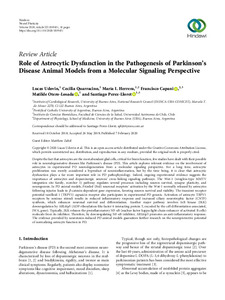Por favor, use este identificador para citar o enlazar este ítem:
https://repositorio.uca.edu.ar/handle/123456789/9942| Título: | Role of astrocytic dysfunction in the pathogenesis of parkinson’s disease animal models from a molecular signaling perspective | Autor: | Udovin, Lucas Daniel Quarracino, Cecilia Herrera, María Inés Capani, Francisco Otero Losada, Matilde Pérez Lloret, Santiago |
Palabras clave: | ASTROCITOS; CELULAS GLIALES; ENFERMEDADES NEUROGENERATIVAS; ENFERMEDAD DE ALZHEIMER; CEREBRO; SEÑALIZACION INTRACELULAR | Fecha de publicación: | 2020 | Editorial: | Hindawi | Cita: | Udovin, L.D., et al. Role of astrocytic dysfunction in the pathogenesis of parkinson’s disease animal models from a molecular signaling perspective [en línea]. Neural Plasticity. 2020. doi:10.1155/2020/1859431 Disponible en: https://repositorio.uca.edu.ar/handle/123456789/9942 | Resumen: | Resumen: Despite the fact that astrocytes are the most abundant glial cells, critical for brain function, few studies have dealt with their possible role in neurodegenerative diseases like Parkinson’s disease (PD). This article explores relevant evidence on the involvement of astrocytes in experimental PD neurodegeneration from a molecular signaling perspective. For a long time, astrocytic proliferation was merely considered a byproduct of neuroinflammation, but by the time being, it is clear that astrocytic dysfunction plays a far more important role in PD pathophysiology. Indeed, ongoing experimental evidence suggests the importance of astrocytes and dopaminergic neurons’ cross-linking signaling pathways. The Wnt-1 (wingless-type MMTV integration site family, member 1) pathway regulates several processes including neuron survival, synapse plasticity, and neurogenesis. In PD animal models, Frizzled (Fzd) neuronal receptors’ activation by the Wnt-1 normally released by astrocytes following injuries leads to β-catenin-dependent gene expression, favoring neuron survival and viability. The transient receptor potential vanilloid 1 (TRPV1) capsaicin receptor also participates in experimental PD genesis. Activation of astrocyte TRPV1 receptors by noxious stimuli results in reduced inflammatory response and increased ciliary neurotrophic factor (CNTF) synthesis, which enhances neuronal survival and differentiation. Another major pathway involves IκB kinase (IKK) downregulation by ARL6ip5 (ADP-ribosylation-like factor 6 interacting protein 5, encoded by the cell differentiation-associated, JWA, gene). Typically, IKK releases the proinflammatory NF-κB (nuclear factor kappa-light-chain-enhancer of activated B cells) molecule from its inhibitor. Therefore, by downregulating NF-κB inhibitor, ARL6ip5 promotes an anti-inflammatory response. The evidence provided by neurotoxin-induced PD animal models guarantees further research on the neuroprotective potential of normalizing astrocyte function in PD. | URI: | https://repositorio.uca.edu.ar/handle/123456789/9942 | ISSN: | 2090-5904 (impreso) 1687-5443 (online) |
Disciplina: | PSICOLOGIA | DOI: | 10.1155/2020/1859431 | Derechos: | Acceso abierto | Fuente: | Neural Plasticity. 2020 |
| Aparece en las colecciones: | Artículos |
Ficheros en este ítem:
| Fichero | Descripción | Tamaño | Formato | |
|---|---|---|---|---|
| role-astrocytic-dysfunction-pathogenesis.pdf | 1,15 MB | Adobe PDF |  Visualizar/Abrir |
Visualizaciones de página(s)
248
comprobado en 24-dic-2025
Descarga(s)
177
comprobado en 24-dic-2025
Google ScholarTM
Ver en Google Scholar
Altmetric
Altmetric
Este ítem está sujeto a una Licencia Creative Commons

